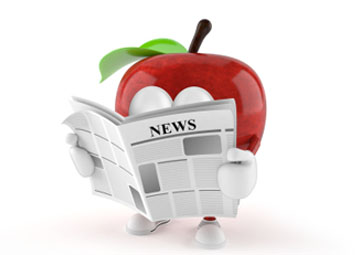Ask a Dietitian

"Diana, just a quick heads up to let you know we are still using your cookbook and the guys will often be heard saying what would Diana say about this or that....really good feed back... I made your potato salad and the oriental coleslaw on Sat. for a family luncheon and had rave reviews so thanks again."
BC Hydro
Iron… a 9 month old baby needs more than a man
As seen on BCTV July 16/02
IRON- A NINE MONTH OLD BABY NEEDS MORE THAN AN ADULT MAN
Why does my baby need iron?
Iron:
- Carries oxygen from the lungs to all parts of the body
- Helps build red blood cells
- Helps cells work in the body
- Helps the brain developDid you know…? Infants between 7 to 12 months of age are growing so fast that they need more iron than an adult man.
How does my baby get iron?
Before six months:
Full-term babies use the stores of iron that they were born with, along with the iron from breast milk or iron-fortified formula.After six months:
Your baby will need iron from food in addition to the iron from breast milk. The main sources of iron for babies are iron-fortified infant cereals, iron-fortified formula and puréed/mashed meat, fish and poultry.Did you know…? Young children with iron levels below normal do not learn as well.
What are the best sources of iron?
There are two kinds of iron in foods.
1. Heme iron is the most easily absorbed by the body.
Foods with heme iron: - Beef
- Lamb
- Pork
- Liver
- Veal
- Turkey and chicken (dark meat has more iron)
- Fish2. Non-heme iron is not absorbed as well as heme iron.
Foods with non-heme iron: - Cereals (fortified with iron)
- Breads and pasta (whole grain and enriched)
- Lentils, dried peas, beans
- Dried fruit (raisins, apricots)
- Dark green, leafy vegetables
- Eggs (before 1 year of age offer only egg yolks, not egg whites)Did you know…? Most red meats, like beef and lamb, have more iron than poultry or fish.
Ways to get the most iron from food
1. Go for heme:
Meat, fish and poultry help the body absorb the non-heme iron from other foods.2. Add vitamin C-rich foods to meals.
Good sources of vitamin C: - Cauliflower, broccoli, Brussels sprouts
- Green, yellow and red peppers
- Cantaloupe, mango, kiwi, strawberries
- Oranges, grapefruits, clementines, mandarins
- Tomatoes, turnips
- 100% juices (orange, tomato and apple with added vitamin C)Did you know…? Eating meat, fish or poultry and vitamin C-rich foods can increase absorption of non-heme iron by up to 4 times.
Easy steps to iron-rich eating for 6-12 month old
- Breastfeed your baby for at least 4 to 6 months. If you decide not to breastfeed, or when you stop, feed iron-fortified formula until at least 9 to 12 months of age.
- Introduce cow’s milk after 9 months of age because it is a poor source of iron.
- Introduce iron-fortified infant cereals at 4 to 6 months of age and continue to feed until 2 years of age.
- Introduce other iron-rich foods, such as meat, between 6 to 9 months of age.
- When you offer foods high in non-heme iron, include meat, fish, poultry and/or vitamin C-rich foods at each meal or snack. This increases the absorption of non-heme iron from foods.
- Try this tasty idea!Puréed of Meat
250 mL (1 cup) cubed meat
125 mL (1/2 cup) water or cooking water from vegetablesSuitable foods to prepare:
Beef, lamb, pork, veal, turkey or chickenMethod:
- Place meat and water in a saucepan and bring to a boil. Reduce heat and simmer for about 45 minutes or until meat is tender and cooked throughout.
Microwave method: Place meat and water in microwave-safe bowl and heat on High until meat is tender and cooked throughout. - Remove from the heat and cool slightly.
- Blend or purée the meat. If needed, add more boiled water.
- Refrigerate for up to two days. Freeze remaining purée in single servings in ice cube trays.
- Contact your local Health Department for more information on making your own baby food.For picky eaters, combine puréed meat with puréed fruits or vegetables, such as applesauce, squash, sweet potato, or any of their favourite foods.
The next steps to iron-rich eating for 1 to 3 year olds
- Offer a variety of iron-rich foods.
- Combine non-heme iron foods, such as breakfast cereals, vegetables and baked beans, with meat, fish, poultry and/or vitamin C-rich foods, such as oranges, strawberries, tomatoes or red peppers.
- Try not to offer too much juice or fruit drinks. This may decrease the amount of food your toddler eats, including iron-rich foods. When it comes to milk, offer a toddler at least 2 cups (500 mL) of milk each day.
- Encourage a healthy eating patter by offering a variety of foods from Canada’s Food Guide to Healthy Eating.
- – Grain Products: breads, cereals, pasta and rice
- – Vegetables and Fruit: dark green and orange vegetables and orange fruit
- – Milk Products: milk, cheese, yoghurt
- – Meat and Alternatives: meat, fish, poultry, eggs, dried beans, peas and lentils
- Iron is important for all members of the family. Make iron-rich foods a regular part of your meals.Info also available at: http://www.beefinfo.org/pdf/II.pdf
If you have concerns or questions about iron, talk to a registered dietitian, your family doctor or pediatrician.
Source:
Beef Information CentreWatch for the Eating for Energy segment on BCTV’s Noon News Hour!